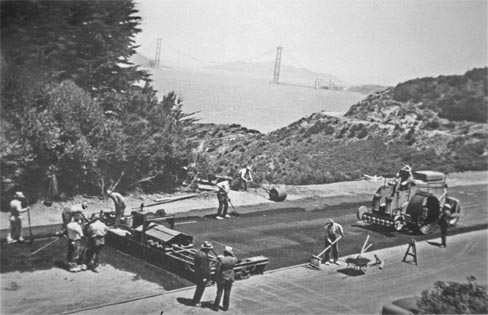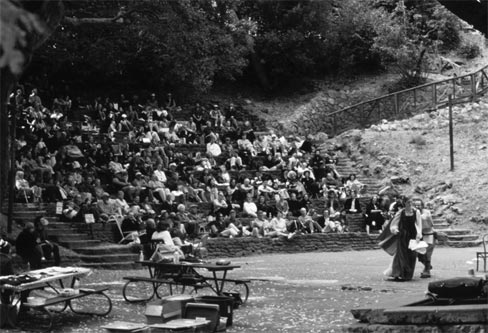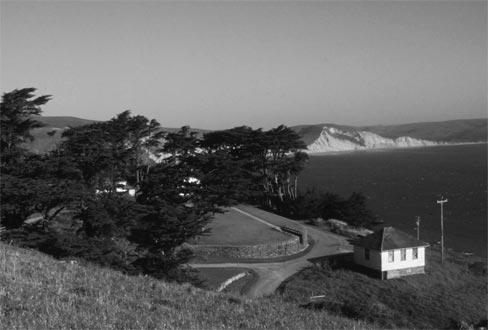Research Report
California's Living New Deal Project
by Lindsey Dillon and Alex Tarr
President Franklin Roosevelt's New Deal looms large in the collective American memory as one of the most important public programs of the 20th century. Yet people today often forget that New Deal agencies created much of our public infrastructure in both city and countryside as well as beautiful art works that adorn public places.(Figure 1)
 |
Figure 1. A WPA crew paves Harding Boulevard in San Francisco. (Courtesy of National Archives and Records Administration.) |
In the fall of 2004, geographer Gray Brechin, a visiting scholar at the University of California, Berkeley, and photographer Robert Dawson began to document the physical legacy of New Deal-era public works in California.(Figure 2) With a seed grant from San Francisco's Columbia Foundation, they traveled the state recording, in text and photographs, the New Deal's most visible legacies. They rediscovered the New Deal landscape in California, and also investigated how so many useful and enduring structures could have been built in such dire economic circumstances.
 |
Figure 2. The San Francisco-Oakland Bay Bridge was completed by the WPA in 1936. (Photograph courtesy of Robert Dawson, 2005.) |
No one had attempted to document and map all of the public works created in one state by the Civilian Conservation Corps (CCC), Works Progress Administration (WPA), Public Works Administration (PWA), and other "alphabet soup" agencies. Because World War II brought an abrupt end to these efforts, the agency records are scattered, spotty, and imperfectly preserved. In 2007, geography professor Richard Walker brokered a supportive connection between the project, the California Historical Society (CHS), and the California Studies Center at the University of California, Berkeley's Institute for Research in Labor and Employment (IRLE) to establish California's Living New Deal Project. With additional funding from the Columbia Foundation, CHS hired Lisa Ericksen as project manager and research assistants Lindsey Dillon and Alex Tarr. Even with a larger team and funding, the complete record of what New Deal agencies accomplished in California remains difficult to piece together.
Research has taken project scholars through a wide variety of archives and across the state. They have scoured minutes of city meetings from the 1930s, old newspaper and magazine articles, college theses, and papers from historical societies for information about what was actually built, retrofitted, painted, and sculpted. For example, the California CCC museum, located at Cuesta College near San Luis Obispo, houses dozens of boxes of original files from CCC camps in California. While incomplete, these records reveal the extensive amount of tree-planting, trail-cutting, stonework, and other important CCC contributions to California parklands.
This research documents a broad landscape of important public resources built by New Deal agencies. For example, most airports in California are New Deal constructions. While the PWA built big airports in urban areas, the CCC was responsible for most of the rural airports in California. These originated as emergency landing strips and today are invaluable to rural populations. In rural and urban areas alike, the WPA built hundreds of schools and often embellished them with artwork, such as sculptures, mosaics, and murals. Other important contributions to civic life left by the New Deal include many of California's bridges, post offices, courthouses, playgrounds, and parks.(Figures 3, 4)
 |
Figure 3. John Hinkel Park Amphitheater in Berkeley was built by the Civilian Works Administration (CWA) and opened in 1934. (Photograph courtesy of Gray Brechin, 2005.) |
 |
Figure 4. This rock wall at Point Reyes was built by the WPA prior to the area becoming a National Seashore. (Photograph courtesy of Gray Brechin, 2005.) |
California's Living New Deal Project aspires to reintroduce this legacy of the New Deal to as many people as possible while simultaneously reinvigorating conversations about the promise and potential of large public works. In addition to writing a book about the transformations that took place in California under the New Deal, Brechin has been delivering multimedia presentations to audiences throughout the state ranging from historical society members to public school teachers. Much of the research is already publicly available on the IRLE-hosted website that allows visitors to explore and contribute to the ever expanding database of New Deal sites in California.
At the heart of the website is an interactive map that displays a small marker for each New Deal project in the database.(Figure 5) Visitors to the site can explore the map by a region of interest and/or a particular type of site. For example, one could ask the map to display all parks and recreational areas in Los Angeles County. Each marker on the map links to a webpage for that particular New Deal project. Visitors can see both archival and contemporary photographs and read about what agencies were involved with the project, including its cost, duration, employment levels, and much more, depending on what information has been found.
 |
Figure 5. Screen capture of California Living New Deal History website shows San Francisco Bay Area projects. http://livingnewdeal.berkeley.edu/. |
The website also provides a forum to share knowledge about the New Deal in California and to collaboratively build the database. Visitors to the website can submit information about New Deal projects in their own communities and also read the stories of others who have shared their memories and experiences. These submissions can fill notable gaps in the public record of New Deal projects. They also are important testaments to the "living" aspect of the New Deal.
A research librarian recently wrote to the project about her morning swims at a WPA swimming pool in Los Angeles. Another woman wrote about watching WPA artist Belle Baranceanu paint two murals in her high school in San Diego in the 1930s, and about going on a date to see the WPA opera in San Diego's Balboa Park. These submissions help to build the Living New Deal Project—an accessible and dynamic public record of buildings, murals, trails, parks, and other amenities enjoyed by the public for over 70 years.
The project continues to grow as more people visit the website, contribute, and share information. The daunting number of sites already recorded by California's Living New Deal Project just begins to scratch the surface of what was constructed under the impetus of the New Deal in California. The worsening economic conditions of our own times and current public debate over the value of large, publicly funded works brings a new resonance and a deeper sense of urgency to gathering and appreciating the full record of the Living New Deal in California and throughout the United States.
About the Authors
Lindsey Dillon and Alex Tarr are doctoral students in geography at the University of California, Berkeley. The Living New Deal History website can be accessed at http://livingnewdeal.berkeley.edu/.
